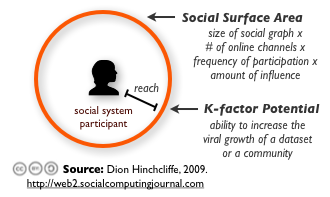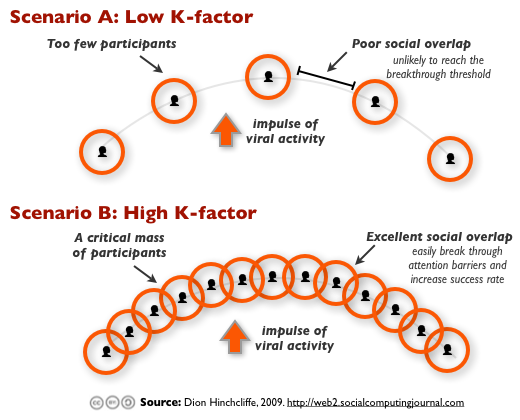Recently for some work that I’m doing I had to revisit the techniques for creating successful online social environments. This is a surprisingly deep and nuanced topic that we as Web application architects or enterprise social computing practitioners are just now fully beginning to grasp. The subject matter itself runs the gamut from key conceptual underpinnings — esoteric topics like systems theory and network effects — to the daily grind of understanding and managing the needs/expectations of an often difficult-to-control community of actual, live people.
In general, I’ve found that the ideas behind social systems themselves are clean and elegant while dealing with their practical realities can definitely be messier and many find them annoyingly unpredictable as well. In the end, online social ecosystems are invariably a fascinating mix of the classic vagaries of technology and people. However, despite the apparent science, making them grow into something undeniably successful is still very much an art form.

Interestingly, there’s no real name for this skill yet and it’s an important — even vitally strategic one — for any organization that has to engage with a lot of people over a network. And that’s increasingly most of us in these days of the ever-present Facebook news feed, Twitter microblog, and workplace Enterprise 2.0 environment. It also means that creating a workable online community requires a good dose of hard-nosed engineering as well as highly effective “soft” skills in UX design, social architecture, and community management. For it to really work — to have a vibrant and growing community — you have to seamlessly connect both of these worlds: a well-crafted social environment together with the people that will use it. The rewards for doing it successfully speak for themselves: Ultimately, businesses and communities are groups of people, and if they produce more value for each other together than they can individually, then there is something in it for everyone. And the online world lets us create these entities far easier, more quickly, and with larger populations than ever before in history.
Related: Network effects are just one of several dozen “power laws” that social architects must know today.
We used to call this process “founding a business” or “creating an organization”. We would call the people that did this entrepreneurs or occasionally philanthropists if their goal was non-commercial. But this terminology doesn’t seem to apply as much to what’s happening now. For one thing, communities are organized differently and frequently have other motivations for participation than the usual one for traditional businesses: the worker/employer relationship. Second, the output of large distributed online communities — especially when focused on discrete outcomes — can greatly exceed the results produced by densely concentrated single institutions. While we are certainly in the very early days of this phenomenon, I’ve frequently pointed to numerous examples of these new models for creating shared value.
So putting aside the socialism vs. capitalism arguments for now (they are increasingly brought up in this discussion, though why they don’t seem to apply here is the subject of a future post) the 21st century networked economy — powered by people and knowledge connected together globally at virtually no cost — has set free fundamentally new ways of innovating and collaborating for mutual benefit. Specifically, it’s the rules for how these new mechanisms thrive and create value that is the object of discussion here.

For my own part, I’ve been fortunate to encounter ways to reduce the concepts for creating growing social ecosystems to a short list, the key ones which I’ll present here. Please be warned, some jargon is necessary, but I will explain it along the way.
How To Create Self-Sustaining Social Ecosystems: The K-factor Lesson
Like my 50 Essential Strategies for Web 2.0 Products, this overview cannot possibly be exhaustive. It does however highlight the central idea behind all successful communities: They are either busy growing or they’re busy dying. Gaining critical mass early on is another important lesson that we’ve garnered from the early Web 2.0 pioneers. Finally, the aforementioned and mysterious K-factor is introduced and explained below.
- Fiat and network effects are the two primary ways that social ecosystems grow. The first is based on an explicit or implicit mandate of some kind. An example of a fiat is when an organization requires participation in a particular social group, perhaps a committee or online community. The second, a network effect, is when a social group has more value the more that other people are involved in it too (which is usually, but not always the case.) Keep in mind that the degree of value in each new member, or their contributions, is based on the structure or design of the social system and will vary greatly. Also note that the fiat approach that is common in business today is a top down effort to “push” participation, while network effects are a “pull” method and tend to be more bottom-up and organic. Background: Read more about push vs. pull systems. Critically, the degree to which a network effect is realized can be influenced by many factors not the least including the intrinsic nature of the social ecosystem itself and how it is connected to the rest of the network (the Web or your intranet.) In general, network effects will ultimately be more successful than fiat for most purposes, especially since the use of social systems are so often made optional, even in business environments.
- Network effects can be encouraged by promoting self-sustaining growth via feedback loops (aka virality). One of the myths of the online world is that viral growth can’t be engineered. While it’s sometimes not straightforward, it can indeed be created intentionally. While cynical uses of virtuous growth cycles won’t produce results for long, the basics work best: letting any user improve the community by contributing knowledge, often to a lightly structured data set or encouraging them to invite their friends and colleagues. In fact, any good social ecosystem will make it easy and rewarding to do so, such as allowing users to discuss, converse, jointly edit, or otherwise work together on common goals. Stated another way, the future of software applications that don’t provide more value when more people are present in an interaction is probably going to be fairly short. A good place for more background on the lifecycles of systems (social or otherwise) is William Varey’s Unlimited Growth.
- Measure your K-factor and keep it above 1. The K-factor of an ecosystem is a statement of whether your network effect is self-sustaining or not. A K-factor of less than one means that your organic growth level is falling (exponentially) and a K-factor of greater than one means that it’s growing naturally and again, exponentially. How to increase your community’s K-factor? There are literally countless ways but allowing users to contribute to hard-to-recreate data set, adding user distributable widgets that provide useful offsite functionality, as well as integrating meaningfully with 3rd party social networks through their application model are a few of the more popular and effective ones. I explored some of these distribution approaches in more detail a while back in my overview of the new distribution models of the Web.
- The higher the social feedback loop intensity, the higher the breakthrough factor. Feedback loops are created for example when a user invites another user to the community and then that user invites their friends and so on. However, the quality of the feedback loop is a measure of how often it reaches outside of the community and how effective that outreach is (often stated as k = e * i, where “e” is the efficiency of the feedback loop and “i” is the average number of invites per user.) An individual user’s ability to affect the quality and intensity of the feedback loop is usually a measure of their social surface area, which I generally consider to be the size of their social graph x the number of online channels they use x the frequency of participation x the amount of influence they exert. If you have a social ecosystem with a lot of influencers or users that are very active online, they will clearly fuel the response to your feedback loops more effectively. The design of the social environment itself also has a major effect depending on whether it makes it easy to invite others or otherwise create feedback loops. A breakthrough factor is achieved when the feedback loops rise above a certain threshold of attention, such as when multiple invites come from multiple persons over a short interval of time. When this threshold is crossed for a prolonged period, the K-factor increases much more rapidly. This rise can be self-sustaining (the so-called virtuous cycle) and can lead to a permanent and dramatic growth climb as evidenced by many of the popular social networks early on, such as MySpace and Facebook.
- External “high impulse events” can be used in the short term as a catalyst to reach the breakthrough factor. This was famously the case with MySpace which used a database of 50 million e-mail addresses to drive initial users to the site, whereupon their feedback loops soon created a particulary strong breakthrough factor. Traditional marketing is often used as the seed to drive the initial population of communities, but unless the K-factor soon rises above 1, the long-term cost of this approach is usually prohibitive. It’s worth noting that it all my research, I’ve never encountered a community that was successful long-term without naturally self-sustaining growth. This is the K-factor lesson of this post’s title: You can grow any community in the short term using artificial means but it will only last and continue to grow on its own because of the inherent quality of the people and the knowledge that has accumulated. That said, you must get your community growth primed in some way. High impulse events can include (by no means exhaustive) traditional marketing, paid incentives (expensive but Paypal was very successful with this model in its early days), and — particularly for business communities — seeding initial high value content.
- Growth in a social ecosystem is not endlessly exponential and eventually hits a ceiling. Plan for it. Typically described by the S-curve, it is encountered when you either fight an existing network effect or when resources are exhausted on the network. While hitting the upper bound of the S-curve is desirable and denotes a successful system (Facebook is just hitting this now), it can also be an indicator of a failure or a bottle-neck in the feedback loop design. A false S-curve is most often evident in my research when a community undergoes a major UX redesign and users have to find their way again, often unable to find and use the features that drive growth and sustain the commuity. Be aware of this and guard against the potential causes of premature S-curves.
I’ve written in the past about deliberately creating emergent phenomenon and then capturing some kind of value from it. Like most efforts on a fixed scale of zero to the maximum possible result, there is a reverse bell curve effect, meaning that most people will get middling results, some will get very poor, and some will hit it out of the park. From the projects I’ve been involved in, I find that the most successful social efforts are ones that are highly agile and willing to capture lessons learned early and often and then make changes quickly and do it all over again the next week. The Web favors those who experiment, adapt, and evolve and thus should go your social ecosystems.
Good luck with your social media and Enterprise 2.0 efforts. Please don’t hesitate to ask questions below or contribute your own wisdom.
